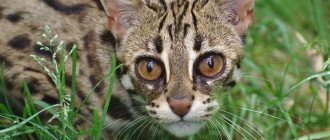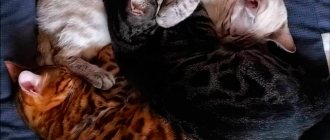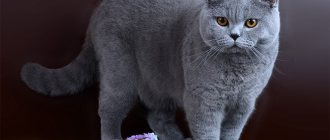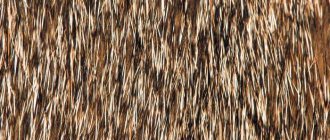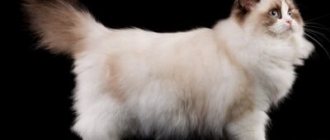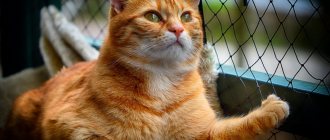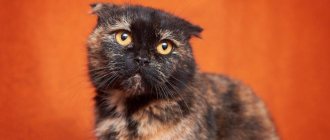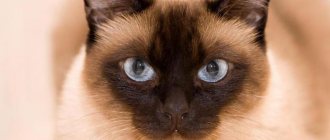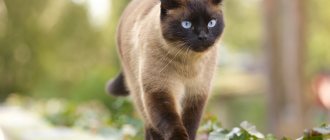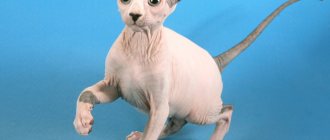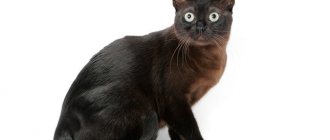The most popular hybrid spotted cat breeds
Most of these are animals obtained by crossing with wild cats.
Bengal
A hybrid of the Asian Leopard Cat or Lesser Leopard (ALC) and a domestic cat, bred by American breeder Jean Mill. Selection work began in 1961. Today the breed is recognized by all felinological systems of the world. The animal has been a pet since the fourth generation.
The first individuals were exclusively “golden” in color - there were black spots on a red background. With the development of the breed, pets of different colors were obtained:
- silver - the main background is silver;
- snow - in three modifications - linx, mink and sepia;
- marble - the spots merge into a large “cloak” or “sparble” pattern;
- charcoal - on a black background there are marks of the same color, while this is an experimental color.
Today, especially popular are individuals whose spots on the skin are arranged in the form of “rosettes”, reminiscent of the pattern of a jaguar’s fur. The most valuable pattern consists of three colors.
Even Bengals of the Siamese-Himalayan type have been bred. But no matter the color, the coat is the main distinguishing feature of this breed. It must have a “wild” pattern and is of the highest quality - short, without undercoat, tightly adjacent to the muscular body, glittery.
A kitten experiences phasing at two to five months, a process characteristic of wild cats. The bright pattern is hidden under the long secondary hair. The baby “blooms” to the age when his physical development allows him to protect himself from enemies and obtain food, in full accordance with natural canons.
Excessive hair loss occurs only during this period of time; in adult life, the Bengal cat does not shed.
This charming animal is rightfully called the “domestic leopard” due to its exceptional exotic coat pattern and energetic temperament.
Read more in the article about Bengal cats.
Toyger
This is a “defective” Bengal, in which the standard prohibits the merging of spots into stripes.
Toyger
The genetic fixation of this deficiency helped the emergence of a new breed. It was created by Judy Sugden, daughter of Jean Mill. Not all felinological systems have yet received recognition.
The colors of the Toyger are the same as those of the Bengal cat.
Also read the article about toygers.
Savannah
The largest modern cat breed. It is a hybrid of Serval and Abyssinian. Registered by breeder Patrick Kelly in 2001 in the American felinological system TICA.
Savannah got the leopard coloring from a wild ancestor. Its color varieties are gold, silver, brown (ed), chocolate, cinnamon.
By nature, these cats are very curious and intelligent, easy to train. They do not tolerate loneliness well. Active, jumping and busy pets need a lot of space to play and love water very much.
Also read the article about savannas.
Serengeti
A hybrid of Bengal and Oriental was created in California in 1994 by breeder Karen Sauzman. Due to its close resemblance to the Bengal cat, the breed is not widespread. Registered only in the American TICA system.
A few miracles at last
It is probably worth recalling that mystics and occultists of all stripes (including the legendary Baba Yaga - the progenitor of modern witches and sorceresses) have always been very kind to cats and considered these animals to be conductors of cosmic energy, fighters against evil spirits and the best brownie friends. Some people, for example, firmly believe that every cat has nine lives. And others assert with full confidence that:
- a black cat can protect its owner from the evil eye, and the house from a thief;
- a bicolor cat doubles the owner's success;
- a tortoiseshell cat ensures family happiness;
- “stripe” helps owners approach life with ease and problems with humor;
- the ginger cat knows how to heal;
- the gray cat restores harmony in the surrounding space and the souls of people;
- A white cat guarantees the owner purity of thoughts.
To believe this or not, everyone, of course, decides for himself. But even without supernatural skills and abilities, cats remain truly amazing animals: wise, independent, forgiving and royally allowing themselves to be loved.
Video: how to choose a cat by color
Yes, cat colors are very different. The painted fur coats of some individuals can make an aspiring impressionist artist cry with envy. But, hand on heart, admit: we love them not for this at all. Harmful, capricious, sometimes downright evil, and not even always reciprocating our feelings—what is it about these animals that attracts us so much? Maybe because for ten thousand years man managed to domesticate the cat, but was never able to tame it? Maybe we value them precisely for their independence and love of freedom? Although, of course, if the cat is also beautiful, this adds points to it. People... What will you take from us?
The most popular spotted breeds of domestic cats
The tabby color is also found in breeds bred without crossing with wild cats.
Ocicat
In appearance it resembles the brightest cat in the world, Ocelot, and got its name in honor of him. Although it has no relationship with a wild cat, but was obtained by crossing a Siamese and Siamese-Abyssinian mestizos.
By its temperament, the Ocicat is a cheerful and playful pet, loyal and affectionate, sociable and loving.
The colors vary in color, but always with spots.
Read more in the article about Ocicats.
Egyptian Mau
Descended from common street cats of Cairo. Exported to America in the fifties of the last century. One of the oldest natural breeds in the world.
The color of the short, dense coat can be different - silver, bronze, smoky, pewter. But always a tabby - and only a dark spot.
A distinctive feature of his appearance is the “scarab” mark on his forehead and the black “eyeliner” of his expressive green eyes.
This small, muscular and very active cat has a balanced and independent character. She is attached to people, does not like loneliness, and is friends with all pets. Loves to talk with family members. The sounds that the Mau makes are not always like meowing, but resemble the “mumbling” of a person.
And you can learn more about this cat by reading the article about the Egyptian Mau on our portal.
Pixiebob
The Elf with the Short Tail was developed in the United States in 1985. The exact origin of the breed has not been determined; there is a version that wild cats participated in the selection, but this has not been confirmed by anything.
The pixie bob is characterized by the appearance of a lynx with tufted ears and a short tail. Polydactylism is common. The short or semi-long coat is always tabby in color - with spots or “rosettes”.
In their devotion to humans, these cats resemble dogs. Very calm, attentive and observant pets are friendly and love to play with children. They swim excellently, climb trees, hunt, “talk”, making beautiful curling and chirping sounds. They get along well with other pets, but are always leaders.
British Shorthair and Scottish Fold cats
The British and Scottish Fold are essentially different types of the same breed, although they are registered separately in feline systems. These are some of the most popular and oldest domestic breeds in the world.
By nature, these pets are self-sufficient, almost always phlegmatic. They like to sleep, but are not fans of active pastime. They are attached to people, love and do not offend children. Unpretentious and calm.
The colors of these cats are varied, spotted colors are very common.
American Shorthair (Kurzhaar)
This breed developed from its European relatives, who migrated with humans to America. A group of breeders began working on the approval of the variety at the beginning of the twentieth century.
The most famous color is the silver tabby - bright black, rather large spots on a light gray background.
The character of the American is called the “golden mean”, the cat is calm, does not require constant human attention, is moderately active and very devoted to the owner and all household members.
European Shorthair
The spotted color of this oldest breed is widely popular. The oldest European native variety was registered and presented to the public only in 1982.
A kind, energetic animal is deeply devoted to humans, willingly plays with children and at the same time never loses its hunting instincts.
Siberian
This natural oldest Russian breed most likely descended from Oriental cats brought to Siberia by merchants.
Animals with long hair and a thick undercoat are excellent hunters and have an independent and calm character. They are sincerely devoted to the owner and all household members, but do not like attention and affection imposed on them.
Among the many colors of Siberians, tabby is common.
Maine Coon
The raccoon cat is the pride of Americans. This natural breed has long been in the lead as the largest. The size of an adult cat (length with tail) reaches one and a half meters and weighs sixteen kilograms.
This pet is calm and undemanding, friendly and devoted to humans. But at the same time, like its ancient wild ancestor, it is an excellent hunter.
The colors of the coon are varied, spotted is quite popular.
Read more in the article about Maine Coons.
Color options
Other tones that descendants inherit from their ancestors also participate in the formation of coat shades. All attempts by breeders to create a uniform color were unsuccessful. Any red color looks patterned.
- White and tan is the most popular option. The white gene in this color combination is dominant and suppresses the white spotting of solid colors.
- Gray-red appears if one of the parents has the D gene, which is responsible for color intensity. The most spectacular combination is red, white and gray. This color is often found among outbred cats.
- A red tabby or tabby appears as fine lines, a clear outline of the upper and lower eyelids, and an "M" shape on the animal's forehead.
- The red tabby is a very varied and interesting color that looks like a shaded tabby. Contrast comes in different intensities.
- Black and red - tortoiseshell. Its carriers are cats. The color is often found in Persians and Maine Coons.
The rarest spotted cats
Leopard-colored cats are also among the new experimental breeds that have not yet found recognition.
Australian Smoke (Mist)
Breeder Labor Street from Sydney carried out enormous selection work, which involved simple and purebred cats - Abyssinian, Siamese, Burmese. Among the many colors, tabby is one of the most common.
Mist inherited excellent health from the barn cats, and extraordinary grace and dignity from the elite. Gets along well with any pet, is devoted to people, loves children, is active and energetic. Approved by a limited number of felinological organizations, it is not widely distributed.
Read more in the article about the Australian myst.
California radiant
Despite its wild appearance, this is not a hybrid breed, but a mixture of many varieties of cats - British Shorthair, Manx, Siamese, Angora, Abyssinian.
Created by American screenwriter Paul Casey as a symbol of wild African cats, mercilessly destroyed by humans.
Very smart, friendly, silent and undemanding pets are still very rare and are registered only in the TICA felinological system (USA).
There are eight colors - black, brown, blue, bronze, charkoal (smoky anthracite), red, gold and silver. Always tabby.
Ussuri cat
This natural breed was noticed relatively recently. Most likely, it came from crossing Amur and Siberian cats.
It has been registered as experimental since 1994, but so far its representatives are very rare in the world.
The main color is from golden to fawn, always tabby. A very independent, self-sufficient and proud pet has all the habits of a predator. Temperamentally, he is more like the latter. Doesn't get along well with other animals, is a loner by nature and an excellent hunter.
Soukok or Sokoke (Kenyan Forest Cat)
It is believed that the ancestors of this very rare breed are wild kazonzo and secondarily feral domestic cats.
Through the efforts of the English breeder Jenny Slator, the breed was approved in 1992 in Denmark.
These slender and lithe cats are small in size, but strong and muscular. The dense and short coat can be of different colors, but always tabby, usually merle.
Playful and very intelligent animals are quite willful and independent. At the same time, they get along well with both humans and other pets. Wonderful hunters.
Also read the article about sokoke.
Pixiebob
This is a powerful, fairly large, muscular cat, with deep-set eyes - which gives the look a “wild” expression, tufts at the tips of the ears, a powerful chin and a short tail. In a word, she looks like the North American red lynx, the appearance that breeders strive for. Interestingly, breed standards allow for the presence of extra toes, which is a disqualifying feature for absolutely all other breeds.
Wild spotted cats - pets
Wild leopard cats are very beautiful. The fashion for keeping them at home has arisen more than once in the human community. But not all representatives of the cat world can be safely placed in a house.
Today, only three spotted species are most widespread as pets.
Serval
The African bush cat is a medium cat. Body length with a short tail is up to one and a half meters, weight - up to twenty kilograms. A small head, long legs and high-standing large ears make this animal look like a cheetah.
In order for a Serval to grow up tame, it must be taken away from its mother in the first days of life and fed by hand. Therefore, you should only purchase such a pet from experienced breeders.
A properly raised kitten will grow into a friendly cat, but its wild roots must not be forgotten. An adult must have a separate enclosure.
Food: raw meat only. During growing up, great attention should be paid to ensuring that there is enough calcium in the diet. Children have fragile limbs and fractures often occur.
The Serval's coloring is magnificent - dark spots on a reddish background.
Read more photos and interesting information about the serval in a separate article on Mister Cat.
Ocelot
A very bright animal, resembling a leopard in appearance, although smaller in size.
Less accommodating and less trainable than the Serval. An adult should only be kept in an enclosure. Nevertheless, it is often found today in home keeping because of the extraordinary beauty of its amazing colors. Such a pet named Babao lived with the famous artist Salvador Dali.
Geoffroy's cat
This small wild animal is similar in size to its domestic counterpart.
The brightly spotted skin was highly valued in the fur industry. Today this species is on the verge of extinction and is protected by the CITES Convention.
Therefore, it is now rarely found in home keeping, although it is popular. It is well tamed if at an early age the pet was taken from its mother and raised in the hands of a person. There are only a few breeders of this species, and it is difficult to acquire such a cat.
Interesting facts and signs about ginger cats
Red cats often become heroes of films, comics, cartoons, and TV series. The most famous movie characters are the plump red cat Garfield and Puss in Boots from the cartoon “Shrek.” Red-haired beasts made a splash at the Disney film company! This includes Thomas O'Malley from the cartoon "The Aristocats" and the Cheshire Cat from "Alice in Wonderland."
Fans of Audrey Hepburn will remember the red cat in the movie Breakfast at Tiffany's. Potter lovers will not forget Crookshanks, Hermione’s unusual friend (pictured below).
If in ancient times black cats were feared and considered fiends of hell, then red furry cats were revered and called amulets, fearless defenders of the home.
There is an opinion that if a ginger cat takes care of a sick person, it means that recovery will come soon.
They used to believe that if a ginger cat comes into a house, it brings warmth and harmony. A fiery red cat in a person’s home means wealth.
Cats are excellent diagnosticians and healers. They are placed on the sore spot, and after a while the person notices that the pain and discomfort go away.
To improve family relationships, people adopted a sunny kitten.
Reference. Sometimes owners love their pets so much that they bequeath entire fortunes to them. A cat named Blackie is considered the richest cat in the world. The owner bequeathed her 15 million pounds sterling.
There are some signs associated with the behavior of red cats. For example, if an animal greets a guest warily, then most likely the person has bad thoughts.
If the cat does not lag behind the owner and asks to be held, perhaps it feels negative energy and is trying to remove it.
If a ginger cat crosses the owner's path from left to right before a trip, it is better to reschedule plans or delay them for half an hour.
Characteristic eye color
The genetics of the pupil is less studied than the properties of fur. Researchers suggest the presence of a color gene and some polygenes that are located outside the studied structures and affect the characteristic features of the organism.
Felinologists identify three most common combinations:
- Black cats with green (grn) eyes are a classic color combination.
- The second group is orange, brown and amber-honey (org) eyes.
- The final position is in the copper color range (cpr). Fairytale black cats with red eyes actually come from this category.
When recessive alleles (b, bl) come into play and various shades appear on the cat's coat, the pupil color combinations automatically dilate. But absolutely black cats have only the three listed eye colors.
Serengeti
The breed was developed relatively recently, in 1994, by mixing Oriental, Bengal and Abyssinian cats. Externally, the spotted beauty resembles a puma or a cheetah, having an elegant posture, a large elongated body, widely protruding ears and a short thick tail. The average weight of the animal reaches 10-15 kg, and the jump height can be up to 2 meters. This jumping ability is due to certain anatomical features of the animal - a muscular, developed body and powerful paws that perfectly absorb the landing. To date, the breed has not yet been recognized by the world community, although it is officially registered.
The character of cats is friendly, but with clearly expressed leadership notes. They easily enter into battle not only with their meowing relatives, but also with dogs. They are the first to go on the attack and selflessly win their place in the sun. On the contrary, they behave kindly, softly and tenderly with people. They require a lot of attention and if they don’t have it, they will pester in every possible way, rub, purr and purr until they get what they want. They love active games and hunt birds and rodents with pleasure, but more for pleasure and entertainment than for food.
Nuances of care
To maintain the beauty of a gray fur coat, it is not recommended to walk cats in sunny and rainy weather, since ultraviolet radiation and precipitation lead to the appearance of red spots on the fur.
Caring for blue cats is no different from caring for pets of other colors. The choice of products and tools depends on the length of the coat and the presence of undercoat.
Cats themselves are clean animals and do not need frequent washing. If the pet is heavily soiled, place it in a basin of water, lather the fur with hypoallergenic shampoo and rinse off the foam with running water.
During shedding season, cats with undercoat should be brushed daily. The rest of the time, once a week is enough. To do this, use a furminator or a comb with fine teeth. The procedure begins with the scruff of the neck, gradually moving towards the tail according to the growth of the fur.
Long fur needs more attention. This rule especially applies to Persians. Their soft, airy fur is prone to forming tangles, which are very difficult to untangle. It is recommended to use a slicker brush for combing. If the tangle cannot be untangled, it is cut off with a trimmer or scissors.
Advice. Corn or potato starch will help make combing easier. Rub the wool with it and carefully comb it with a comb.
To clean the ears, you can use mineral oil or boric alcohol, as well as any products from Linnek marked for cats: ProVET, Nutri-Vet Ear Cleanse, TRIXIE Ear Care, Dr. Clauders Ohrenpflege. Dirt and earwax will be removed with a cotton pad; ear swabs cannot be used.
Accumulations in the corners of the eyes are wiped with a cotton pad dipped in tea leaves or warm boiled water.
The claws are trimmed as they grow with a special nail clipper, taking care not to damage the blood vessels. Animals do not like this procedure, so use distracting maneuvers. Ask someone in your household to hold a brush with feathers or a favorite toy in front of the cat's eyes.
Characteristic diseases
Breeds with blue hair are characterized by strong immunity and the absence of serious genetic pathologies. Except that the British and Scots are prone to cardiovascular diseases, and the Persians are prone to pathologies of the kidneys and retina.
Purebred animals rarely suffer from infectious diseases and are not afraid of frost. Nutrition should be balanced. Food can be natural, but without salt and spices. Premium class products are suitable for industrial feed.
Description
Tabby cats become the favorites of many due to their spectacular color.
Fur with brightly highlighted stripes attracts the attention of others and becomes the main distinguishing feature of the pet. There are several variants of striped color, each with its own special characteristics.
Let's take a closer look at them.
Classic (or traditional)
This type of tabby color in domestic cats is characterized by the presence of narrow stripes that are located along the pet’s spine
It is important to note that usually the stripe in the center is a darker shade, while the stripes on the sides are noticeably lighter. In addition, such animals have a pattern on the sides of the body.
Mackerel
A distinctive characteristic of this tabby color is uninterrupted stripes. In addition, they themselves are quite narrow and may have a slight smooth bend. It is not uncommon to see small but distinct markings on the paws and tails of mackerel-colored striped animals. Another characteristic of pets is the presence of dark stripes that run from the outer corners of the eyes to the cheeks.
Striped color with spots
This option is the brightest and most colorful among all existing ones. The variety got its name due to the fact that the stripes that run along the cat’s body are constantly interrupted. In this regard, it may seem that these are not stripes at all, but ordinary spots.
At the same time, despite some differences between individual varieties, tabby cats have certain common features that distinguish them from all other furry pets. These signs usually include:
- a spot in the shape of the letter “M” located on the forehead of a pet (the outline of the pattern, as well as its color and size may vary);
- two types of hair that make up the wool (one of them is the background, and the other is used to draw the immediate pattern);
- there is a pattern in the form of rings on the chest (this pattern may resemble necklaces).
The thing is that a special gene is responsible for such coat coloring, which can manifest itself in any animal. In addition, scientists have discovered a rather interesting fact: the gene responsible for striping also ensures a good and stable immune system.
Another important sign is that tabby cats are endowed with fairly developed intelligence and have pronounced mental abilities. This fact will be useful in the process of training a cat (for example, when you train your pet to use the litter box).
In addition, veterinarians and scientists note that tabby cats are quite active animals that (among other things) have a fairly developed hunting instinct. This is why your pets can bring you rats, mice and other animals they have caught.
Easy and quick adaptation to new environmental conditions, as well as the ability to navigate well in unfamiliar terrain, also distinguish tabby cats from other cats. But it is also noted that animals live quite a long time.
As for the character and behavior of cats, striped pets are distinguished by a rather calm, docile and balanced disposition. They are resistant to various external stresses and withstand unfavorable influences from the outside.
Interesting fact. In nature, no two tabby cats are exactly alike. All pets have a unique color and pattern, unlike any other. Thus, the coloring of tabby cats (like human fingerprints) is an individual characteristic, thanks to which one can distinguish one animal from another.
Egyptian Mau
This is a slender, well-built cat of medium size. Her features are a fold of skin on her stomach, thanks to which the Egyptian is capable of impressive jumps, and a unique eye color of an interesting shade of green, which is compared to the color of an unripe gooseberry. Her character is sociable and friendly.
Egyptian Mau are descendants of the very cats that were so revered in Ancient Egypt. The history of the breed (in the modern sense) began more than a hundred years ago, but almost ended during the Second World War. The restoration of the breed was undertaken by the Russian princess N. Trubetskaya. Of course, it is difficult to say whether the ancestors of modern Egyptian women were descendants of those same ancient Egyptian cats, but it is reliably known that the princess imported animals for breeding work from Cairo.
N
Napoleon
These cats make great pets as they are very sweet and loving, and they get along well with children and other pets. They really don't like to be left alone, so they are best suited for families who will have a lot of time to devote to their pet.
German Rex
German Rex cats are energetic and friendly, and they get along well with anyone, from small children to the elderly. They are quite playful and love activity, so give them plenty of space to run and play.
Nibelung
The best thing about the Nibelungs is their personality. Loving and sweet, they form close bonds of love and trust with their owners and remain extremely loyal and loyal throughout their lives.
Norwegian forest
She has long, beautiful fur, fluffy ears and a shaggy tail. This is a gentle, friendly cat who loves to be around people. The Norwegian Forest is a slow maturing breed, reaching full size at approximately five years of age.
Neva Masquerade
There is a bit of controversy and confusion surrounding the Neva Masquerade. Some consider it as a color variation within the Siberian breed, and others recognize the Neva Masquerade and Siberian as two separate breeds, however some enthusiasts consider it a threat to the purity of the Siberian breed.
